Kiteboarding in Miami: Locations, Tips, and More
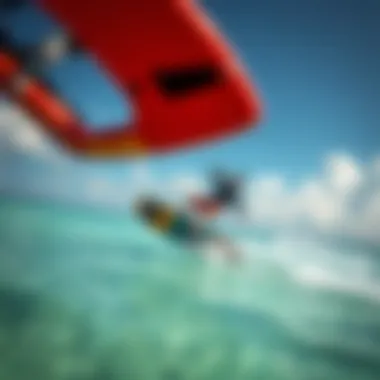
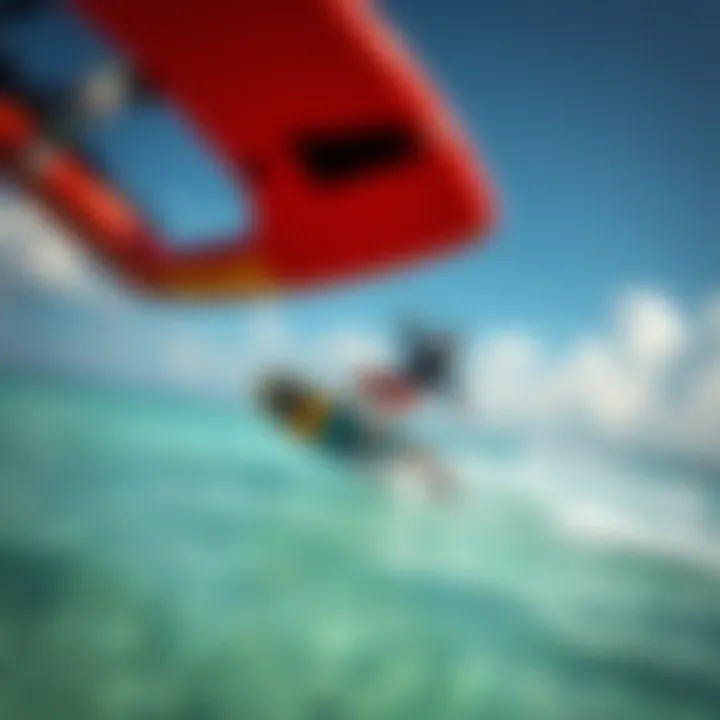
Intro
Kiteboarding, a thrilling water sport that blends the elements of surfing and wind power, has found a vibrant home in Miami's sunny coastline. This city’s warm waters, steady winds, and picturesque locations make it an attractive destination for both newcomers and seasoned riders. The sport carries a unique charm, allowing individuals to harness the winds while gliding atop waves, creating an exhilarating and liberating experience. In this comprehensive guide, we will delve into the fascinating world of kiteboarding in Miami.
We’ll explore the best spots for kiteboarding in the area, highlighting local favorites that offer both challenge and beauty. Important safety considerations will be thoroughly examined, ensuring that everyone can enjoy their time on the water without putting themselves at risk. Kiteboarding gear and techniques will also be discussed in detail, providing insights tailored for beginners as well as advanced riders looking to refine their skills.
By the end, our goal is to arm you with not only the practical knowledge needed to chart your kiteboarding journey in Miami but also with a deeper appreciation for the vibrant community that surrounds this thrilling sport. Let's dive in and discover the best Miami has to offer for kiteboarders!
Surfing Techniques
Advanced Maneuvers for Experienced Surfers
For those who have mastered the basics, Miami presents an array of opportunities for advanced maneuvers that elevate kiteboarding to the next level. Freestyle tricks, such as the kite loop, require precise timing and skill. Riders often gauge the power of the wind and their own navigation to execute these stunts with finesse. Other popular tricks include the backloop, where the kiteboarder rotates backwards while airborne, and the handle pass, which adds an element of flair and complexity as the rider passes the kite’s control bar behind their back.
An essential technique in this realm is understanding the wind's behavior. Experienced kiteboarders often find themselves moving across various locations as they adapt to the shifting forces. Key spots in Miami, like Key Biscayne and Virginia Key, offer ideal conditions to practice these advancements, boasting consistent winds and open spaces conducive to daring performances.
Beginner Tips for Catching Your First Wave
If you’re new, the world of kiteboarding can feel intimidating, but catching your first wave is indeed within reach. Start with the right equipment. A medium-sized kite and a board that's easy to control set the stage for smoother initial experiences.
When in the water, focus on balance and body positioning. Keep your knees slightly bent and your back straight; this will help maintain control as you take off. Begin by practicing in light winds before transitioning to more robust conditions where you can really harness the wind.
- Practice kite control: Start with ground handling your kite; understanding its movements will drastically improve your coordination.
- Work on your stance: A proper stance will maximize your energy efficiency. Feet shoulder-width apart allows for better stability.
- Stay relaxed: Tension leads to mistakes; keeping a calm mindset will help you navigate those early waves with more confidence.
The beauty of Miami’s coast is that there are plenty of spots to cultivate your skills without too much competition, providing a relaxing environment perfect for practice.
"Kiteboarding is not just about riding; it's about experiencing the elements and finding harmony with nature."
Gear and Equipment Reviews
In-Depth Review of the Latest Kiteboarding Kites
Choosing the right kite can make or break your kiteboarding experience. The development of technology in kite design promotes efficiency and stability. Brands like Naish and North Kiteboarding have created kites that are exceptionally versatile, catering to various skill levels. For beginners, the Naish Fly offers a forgiving nature while still providing the power needed for fun. On the premium side, the North Action kite excels for advanced performances, boasting rapid response times and excellent stability.
Essential Accessories Every Kiteboarder Should Have
In addition to your kite, several accessories play a crucial role in optimizing your experience and safety:
- Harness: A comfortable harness distributes the kite’s pull across your body.
- Safety leash: This tool ensures that your kite can safely disengage from you in emergencies.
- Impact vest: While not mandatory, wearing one adds a layer of protection against hard falls.
- Kite repair kit: Accidents happen; having a repair kit can save a day on the water.
With the bustling community in Miami, local shops often provide opportunities to test gear before purchase. Engaging with veterans in the sport can also yield useful anecdotes about what equipment suits the upcoming conditions best.
Prolusion to Kiteboarding in Miami
Kiteboarding in Miami isn't just a sport; it's an exhilarating way of life deeply woven into the fabric of the city. With its spectacular coastlines and constant winds, Miami offers a perfect setting for both novice and seasoned kiteboarders. This guide aims to immerse readers in the world of kiteboarding, highlighting its significance and what makes Miami such a desirable location for this electrifying sport.
At the heart of our exploration are the unique aspects that set Miami apart as a kiteboarding hotspot. The thriving saucy beach culture, mixed with favorable weather conditions for much of the year, creates an inviting environment for enthusiasts to engage this thrilling discipline. Whether you're gliding over turquoise waters or mastering the art of aerial tricks, the opportunities in Miami are boundless.
Understanding the local landscape is crucial for maximizing the kiteboarding experience. For instance, riders must consider factors like wind patterns, tide schedules, and choice of equipment that are perfectly suited for the area. This guide will not only empower you with knowledge about the optimal spots and setups but also ensure you are well-versed in safety measures and community etiquette around Miami's kiteboarding scene.
Benefits of Kiteboarding in Miami
Kiteboarding provides myriad benefits, both physical and mental. Here are some key points to consider:
- Physical Fitness: The sport demands a high level of coordination and engages multiple muscle groups. Riders will find themselves improving strength, balance, and endurance.
- Stress Relief: Kiteboarding can be a great way to unwind. The rhythmic motion of riding over waves, combined with the fresh ocean breeze, has therapeutic effects.
- Community Connection: Miami's kiteboarding scene is buzzing with likeminded individuals. This shared passion fosters camaraderie and opportunities to learn from more experienced riders.
Here’s an aspect worth noting: Being part of the local kiteboarding community enriches your experience. Participating in gatherings or events exposes you to valuable tips and tricks, and it eases the process of finding friends who share your interests.
Kiteboarding in Miami encapsulates not just the thrill of riding waves but also embodies a lifestyle that embraces adventure, connection, and wellbeing. In the upcoming sections, we will delve into the history, prime locations, and the existential factors surrounding this vibrant sport.
The Evolution of Kiteboarding
Kiteboarding has come a long way since its inception. Understanding its evolution provides valuable context for riders today. Not only does it reveal the sport's growth trajectory, but it also sheds light on the technology, techniques, and community that have shaped it. Exploring the development helps enthusiasts appreciate their craft and recognize how far kiteboarding has advanced in terms of safety and performance.
Historical Context
Kiteboarding began in the late 20th century, with various prototypes taking flight along coastlines. The early methods were crude at best, often relying on makeshift kites and boards. The first significant leap was made by the likes of Bruno Legaignoux and his brother in France during the 1980s. They masterminded a patented design that combined kitesurfing with elements of traditional surfing and paragliding. This design didn't just pave the way for a sport; it offered a fresh freedom on the water, drastically shifting the paradigm of what was possible in water sports.
By the 1990s, the kiteboarding scene began to flourish with commercial kites entering the market. Companies like Naish and Slingshot began producing kites designed for ease of use and safety. The shift from expert use to more approachable designs attracted a broader demographic. Non-professional riders could finally try their hands at what had once seemed like an elite sport. As a result, kiteboarding began to infiltrate beach culture, populating local waters and establishing a community eager for adrenaline.
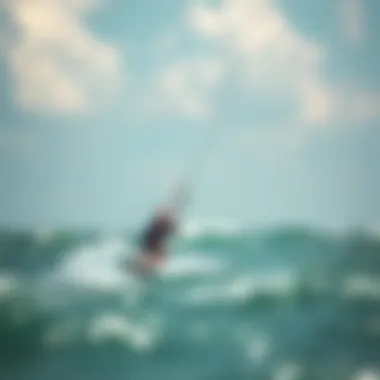
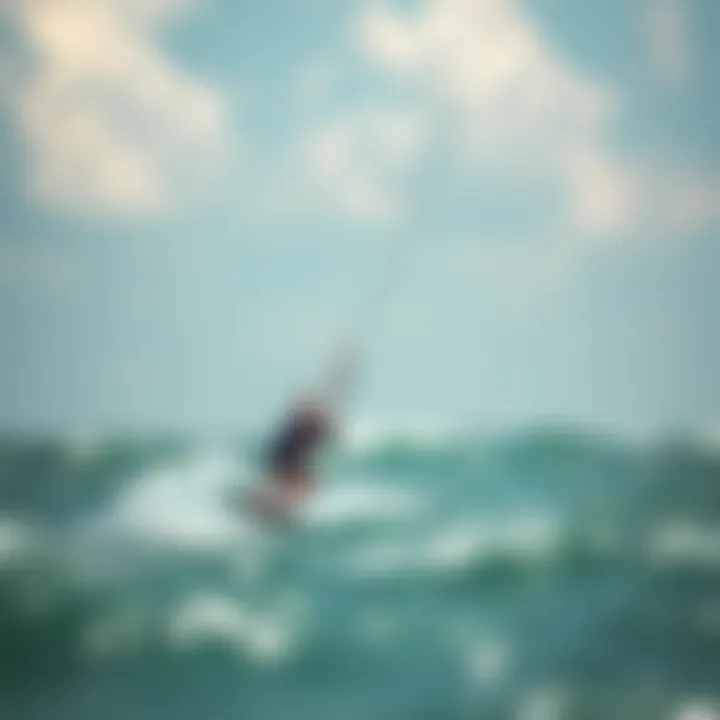
Growth in Popularity
The early 2000s witnessed an explosion in kiteboarding's popularity, fueled by advancements in kite technology and increased media coverage. Thanks to extreme sports media showcasing tricks and competitions, the sport captured the imagination of thrill-seekers globally.
Factors contributing to this rise include:
- Improved safety features in kite design, making it accessible for beginners and ensuring a greater emphasis on rider education.
- The rise of social media platforms—particularly Instagram—where visually stunning footage of riders performing tricks encouraged others to jump on the bandwagon.
- An inclusive community that offered support and resources for new riders. Local shops and schools popped up, providing lessons and affordable gear options.
As kiteboarding blossomed, it became more than just a sport; it morphed into a lifestyle choice for many. Gathering at beaches with vibrant kite colors against azure skies became a common sight. The emotional thrill of harnessing the wind and conquering waves found its way into the hearts of millions, securing kiteboarding’s status as a staple in coastal cultures worldwide.
Emphasizing its growth, it’s significant to note that kiteboarding competitions are now held in various locations across the world, attracting seasoned athletes and budding novices alike. The sport has transcended recreational activities and established itself firmly in the competitive realm.
Ultimately, the evolution of kiteboarding tells a story of innovation, community, and respect for both the ocean and the wind. The journey from rudimentary kites to today's high-performance models signifies not just a sport’s history but also its future. With aspiring kiteboarders embarking on their paths every season, the rich tapestry of this sport continues to weave itself into the fabric of watersports culture.
Prime Locations for Kiteboarding in Miami
When it comes to kiteboarding, having the right spot can make all the difference. The prime locations in Miami offer not only breathtaking scenery but also the wind and water conditions necessary for an exhilarating experience. Each venue lends itself to different skill levels and preferences. Selecting the proper location can vastly influence one's enjoyment and proficiency in the sport. Additionally, accessibility, amenities, and local knowledge play key roles in maximizing the kiteboarding experience.
Miami Beach
Miami Beach stands as one of the most iconic locations for kiteboarding in the world. It offers vast stretches of sandy coastlines and consistent wind conditions that attract both amateurs and seasoned kiteboarders alike. The area provides ample space for launching and landing kites, and its lively atmosphere enhances the overall experience.
The shallow water in many areas makes it a safe choice for beginners, while the more advanced kiteboarders can take advantage of the larger swells on the eastern side. Moreover, having vibrant nightlife and various options for dining post-kiteboarding makes this location a favorite among locals and travelers. Kiteboarding schools such as the Miami Kiteboarding School are nearby, offering lessons and equipment rentals, making it easy to dive right into the action.
Virginia Key
Just a stone's throw from downtown Miami, Virginia Key is often praised for its calmer waters and favorable wind patterns. The environment here is slightly more serene compared to the bustling Miami Beach. It boasts expansive flat water areas, perfect for those who are just starting to master their techniques.
The friendly atmosphere has led to a strong community of kiteboarders, making it an excellent spot to meet fellow enthusiasts. With the famous Virginia Key Beach Park close by, one can chill out post-session, soaking up the picturesque views of the Miami skyline. Additionally, various local shops and rentals ensure that anyone can find the right gear for their session.
Crandon Park
Crandon Park offers a unique experience both for kiteboarders and beachgoers. Nestled at the northern tip of Key Biscayne, this secluded park is known for its stunning scenery and ideal kiteboarding conditions. The sweeping bay provides ample flat water suitable for riders of all skill levels.
What sets Crandon Park apart is its array of amenities, including picnic areas and restrooms, which makes it perfect for full-day outings with family or friends. With a fenced launch area, kiteboarders have a designated space to set up their equipment, ensuring safety and convenience while launching into the water or packing up after a session.
"Kiteboarding is more than just a sport; it’s a lifestyle that unites the ocean, the wind, and a community of passionate riders."
Choosing the Right Equipment
Selecting appropriate equipment for kiteboarding is as critical as knowing how to ride. The right gear not only enhances performance but also plays a vital role in safety and overall enjoyment. Here, we dive into some essential components to help you make informed choices when gearing up for kiteboarding in Miami.
Kite Selection
When choosing a kite, the first consideration should be its size. Kites come in various dimensions, typically ranging from 5 to 17 square meters. The larger the kite, the more power it can generate, which is valuable in lighter winds. Conversely, a smaller kite is ideal for strong wind conditions.
In addition to size, the style of kite varies; there are two main types: C-kites and bow kites. C-kites are often favored by freestyle riders due to their quick response and ability to facilitate tricks. On the other hand, bow kites provide excellent stability and a wider wind range, making them great for beginners.
While selecting a kite, consider also your skill level and the conditions in which you plan to ride. Talk to local experts at a kiteboarding shop or school to gain insights. Try before you buy when possible; personal preferences in handling and control can differ significantly.
Board Types
Choosing the right board is akin to picking the right skateboard for a trick. Kiteboarding boards generally fall into two categories: directional boards and twin-tips.
- Directional Boards: These are similar to surfboards and work well in ocean waves. They are designed for riding in one direction and typically offer a smoother ride in chop and waves. The disadvantage? Mastering turns can take some time, especially for beginners.
- Twin-Tip Boards: These boards allow riders to ride in either direction. They're favored for their versatility and ease of use, making them a common choice for new kiteboarders. Twin-tips are generally lighter and easier to jump with, allowing for a dynamic ride.
Consider board width too. A wider board offers more stability and planing in light wind, while a narrower board enables quicker turns. Check reviews, borrow from friends, or rent before making a purchase to find what feels best for you.
Harness Criteria
When it comes to harnesses, fit and comfort cannot be overstated. A harness that fits well allows for better control and reduces fatigue over a long session. Harnesses are primarily of two types: waist harnesses and seat harnesses.
- Waist Harness: This type wraps around the waist and is ideal for those looking for freedom of movement and quick transitions between tricks. They're lightweight and easy to adjust but may ride up during certain maneuvers.
- Seat Harness: More supportive, these harnesses wrap around your hips and thighs. They are generally recommended for beginners because they distribute the load more evenly, but they can limit your mobility as you progress.
When choosing a harness, ensure that it doesn’t pinch or rub when buckled up. A good harness will feel almost like a second skin. When trying various harnesses, sit down and mimic a riding position to ensure comfort.
Always remember: Investing in the right equipment not only enhances your performance but ensures your safety on the water. Well-chosen gear fosters confidence, allowing you to focus purely on the joy of kiteboarding.
With these pointers, one can set sail confidently into the sky and surf. With the right kite, board, and harness, you're set to transform the exhilaration of kiteboarding into a memorable adventure.


For more on kiteboarding gear, visit Wikipedia or consult with local kiteboarding communities on Reddit.
Safety Considerations
In the exhilarating world of kiteboarding, safety is not just a guideline, it’s an absolute necessity. Miami’s warm breezes and sunny beaches draw kiteboarding enthusiasts from all walks of life, but riding those winds without proper safety measures can be a recipe for disaster. Understanding the safety considerations associated with this sport can mean the difference between a thrilling day on the water or an unfortunate mishap.
Understanding Weather Conditions
Before heading out, being well-versed in the weather conditions is vital. The winds in Miami can change like the flip of a switch, rapidly switching from gentle breezes to intense gusts. It’s crucial to keep an eye on local forecasts. For instance, an overcast sky or a sudden drop in temperature can indicate shifting conditions that you might want to avoid.
Also, watch for signs of storms or lightning. If dark clouds roll in, it’s best to pack it up and find shelter. These kinds of conditions can turn a fun kiteboarding session into a risky situation in no time. Utilize reliable resources like the National Weather Service ( https://www.weather.gov) for up-to-date conditions before venturing out.
Remember, the ocean is no place for guesswork.
Kiteboarding Etiquette
Equally important to safety is kiteboarding etiquette. Respecting fellow kiteboarders and the water environment goes a long way in ensuring everyone has a good time. Here are some fundamental rules to keep in mind:
- Right of Way: Understand who has the right of way on the water. Generally, the rider heading downwind has the right of way over the one headed upwind.
- Launch Zones: Keep launching areas clear. Always check your surroundings before you launch or land your kite.
- Keep Distance: Maintain a safe distance from other riders. Collisions can happen easily, so it’s wise to give each other ample space.
Following these practices not only keeps you safe but also promotes a positive atmosphere in the kiteboarding community. After all, everyone is there to enjoy the thrill of the sport, and cooperation can lead to lasting friendships.
Emergency Protocols
It’s always wise to have an emergency protocol mapped out before heading out. Here’s a basic guideline to follow:
- Buddy System: Whenever possible, kiteboard with a partner. If something goes wrong, having someone on hand can be lifesaving.
- Emergency Signal: Agree on an emergency signal with your buddy so you can alert them to any problems quickly.
- Knowledge of Local Systems: Familiarize yourself with local emergency services or lifeguards. Know how to contact them in case of an emergency.
- First Aid Kit: Having a basic first aid kit can help handle minor injuries promptly. Include items like antiseptic wipes, band-aids, and something for any allergic reactions.
Being prepared for emergencies might not seem exciting, but it is part and parcel of responsible kiteboarding.
In summary, keeping safety at the forefront is essential for an enjoyable and fulfilling kiteboarding experience in Miami. By understanding weather conditions, respecting fellow riders, and having a firm grip on emergency protocols, riders can focus on the sheer joy of the sport.
Kiteboarding Techniques
Kiteboarding techniques are paramount, serving as the backbone of one’s experience on the water. Understanding various techniques not only boosts skill levels but also enhances enjoyment and safety. As varying wind conditions and personal goals come into play, mastering both basic and advanced maneuvers becomes essential for making the most out of every kiteboarding session.
Effective kiteboarding techniques equip riders to adapt to challenges they may face in Miami’s vibrant but sometimes unpredictable waters. From navigating the waves to harnessing wind power, the techniques one day learned can blossom into a fluidity that translates feelings of freedom and exhilaration. It's a language spoken by enthusiasts, where every flip, jump, and turn tells a story of connection between rider and nature.
Basic Techniques for Beginners
Learning kiteboarding starts with foundational skills, much like laying bricks for a sturdy building. Newbies are often encouraged to first master the basics, which include:
- Kite Control: Understanding how to handle the kite in different wind conditions is crucial. Begin with a trainer kite on land to get the feel before hitting the water.
- Body Positioning: Keeping a balanced stance makes a world of difference. Bend your knees slightly, lean back against the pull of the kite, and maintain your center of gravity.
- Water Start: This technique involves getting up on the board from the water. It’s a bit of fine-tuning and patience, but once you get it, the sense of achievement is something else.
New riders should also practice safety measures. For example, knowing how to launch and land their kites properly protects both themselves and others on the water. Even taking an introductory lesson from a local kiteboarding school can really accelerate the learning curve.
Advanced Maneuvers
Once the basics become second nature, kiteboarders can explore advanced moves that amplify their performance and enjoyment:
- Jumping: This exhilarating maneuver requires timing and technique. Riders take off by edging hard against the wind, using the kite's power to lift off the water. Timing the pull of the bar and the turning of the kite is paramount here.
- Waveriding: It’s all about harnessing the energy of the waves. Riders must master both their kite skills and board control to ride effectively on waves.
- Tricks and Spins: As one gains confidence, performing tricks like the backroll or frontroll comes into play. Practice is key, and the more a rider experiments, the more they'll find their unique style.
These advanced techniques can vary and evolve as riders progress. Beyond just showing off to peers, they enhance a rider’s connection with the water, giving them an exhilarating sense of control.
Engaging with a community, like local Facebook groups or forums on Reddit, can provide valuable insight into fine-tuning these techniques.
Whether you’re a novice looking to get your feet wet or an aficionado eager to refine your repertoire, kiteboarding techniques adapt to fit your journey in Miami’s picturesque waters.
Local Kiteboarding Community
The local kiteboarding community in Miami is not just a group of enthusiasts sharing a passion; it is a vibrant ecosystem that supports, educates, and fosters growth among its members. This community plays a vital role in enhancing the kiteboarding experience for both new and seasoned riders alike. It provides the necessary network to exchange tips, best practices, and local knowledge, which can be invaluable in this sport.
Community gatherings serve as a melting pot for kiteboarders to connect with one another. The importance of building relationships with other kiteboarders cannot be overstated; it nurtures a spirit of camaraderie that can make all the difference when you're navigating the waves.
Benefits of Being Part of the Local Community
- Skill Development: Sharing techniques and tips among community members accelerates learning.
- Network and Support: Making connections can lead to new friendships and riding partners.
- Access to Resources: From gear rentals to lessons, the community often has shared resources that can ease costs.
- Safety Awareness: Engaging with experienced riders helps novices to understand local hazards and etiquette, ensuring everyone's safety.
In essence, being part of the local kiteboarding community enriches the overall experience and promotes safer practices while allowing individuals to grow within the sport.
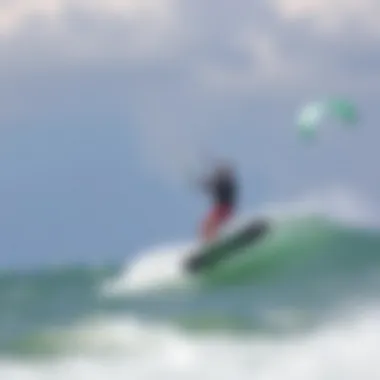
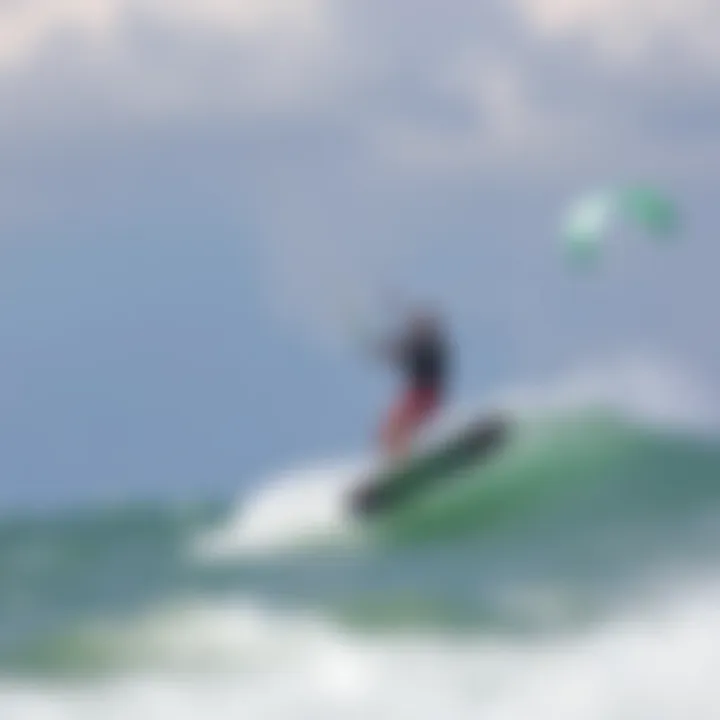
Kiteboarding Schools and Rentals
Kiteboarding schools in Miami serve as excellent gateways for enthusiastic learners keen on picking up the sport. Institutions like Miami Kiteboarding and Kiteboarding Academy offer comprehensive courses tailored to various skill levels. They provide not only equipment but also expert instructions that demystify the complexities of kiteboarding.
What You Get at the Schools
- Structured Lessons: Beginners get a solid foundation, while advanced riders can fine-tune their skills.
- Mentorship: Instructors often have years of experience and can share invaluable insights.
- Safety Training: Understanding safety protocols is critical, and these schools prioritize teaching how to handle various situations.
- Equipment Rental: Schools frequently have a great selection for those who don't own gear, making it easy to try different styles.
These schools have become somewhat of a social hub where you can meet fellow kiteboarding enthusiasts. It turns out, the learning realm does not have to be dry. These environments foster friendships and create lasting bonds.
Community Events and Gatherings
Community events are the heart and soul of Miami's kiteboarding scene. These gatherings can range from informal meetups at the beach to organized competitions that draw participants from all over. They not only offer opportunities for riders to show off their skills but serve as a platform for education and sharing knowledge.
- Beach Cleanups: Many local groups organize cleanup days, contributing to environmental sustainability while enjoying a shared passion.
- Kiteboarding Competitions: Friendly contests allow riders to showcase their skills while promoting a sense of community spirit.
- Social Gatherings: BBQs and parties foster a laid-back atmosphere, perfect for mingling and sharing stories.
Environmental Considerations
Environmental aspects play a crucial role in any sport, especially one like kiteboarding, which thrives on natural elements. In Miami, understanding the environment helps safeguard the scenic beauty and marine ecosystems that embellish the area while providing thrilling experiences for kiteboarders. Emphasizing this topic not only nurtures the passion for kiteboarding but also encourages responsibility among enthusiasts. It's essential that we, as kiteboarders, respect and protect the beautiful coastal environments that we too often take for granted.
Impact on Marine Life
The waters around Miami are a treasure trove of biodiversity, from vibrant coral reefs to unique fish species. Kiteboarding can disturb local marine life if proper precautions aren't taken. For instance, when launching or landing a kite, boarders might unintentionally disturb nesting grounds of sea turtles or disrupt fish habitats. The sound and presence of kiteboarding can lead to stress for marine animals, particularly those that are sensitive to disturbances.
To minimize negative impacts, it is highly recommended that kiteboarders:
- Stay clear of known wildlife areas, especially during breeding seasons.
- Use environmentally-friendly equipment materials that do not shed harmful plastic.
- Follow local guidelines about restricted areas and seasonal closures to protect marine life.
"By being mindful of the ocean's inhabitants, we not only preserve their homes but enrich our own experiences out on the water."
Sustainable Practices
Embracing sustainable practices in kiteboarding isn't just a trend; it's a necessity. Sustainable kiteboarding refers to the actions and choices we make to ensure our passion doesn't harm the environment. Miami, with its beautiful coastlines, is an ideal place to practice sustainability in the sport. Here are some steps that kiteboarders can take:
- Choose Eco-Friendly Gear: Several brands now offer kiteboarding equipment made from sustainable materials or those that reduce waste. Selecting eco-conscious products diminishes your carbon footprint.
- Carpooling and Public Transport: When heading to your favorite kiteboarding spots, consider carpooling with fellow enthusiasts or using public transport. This reduces traffic congestion, lowers emissions, and fosters a sense of community among riders.
- Clean-Up Initiatives: Participate in or organize beach clean-ups to maintain the natural beauty of kiteboarding locations. Even a small act, like picking up trash after a session, can have a lasting positive impact.
- Education: Share knowledge about environmental responsibility with fellow kiteboarders. Teaching newcomers about marine ecosystems and their sensitivity can help instill a culture of respect for nature.
Ultimately, practicing sustainability in kiteboarding not only nurtures the environment but also enhances our own enjoyment of the sport. When we take care of the ocean, the ocean takes care of us in return.
Traveling for Kiteboarding
Traveling for kiteboarding goes beyond just packing your gear and hitting the road. It’s about diving into new experiences and discovering different kiteboarding cultures around the globe. This section highlights why traveling is crucial for kiteboarders and what you should consider when looking to explore the waters outside of Miami.
Adventure awaits kiteboarders as they search for the best spots that offer not only suitable wind conditions but also breathtaking backdrops. Some might say that the journey is just as significant as the destination itself, and this is especially true in the kiteboarding community. Each location brings its own unique challenges and joys, making it essential for riders to explore diverse environments. Whether it's the gentle breezes of the Caribbean or the gusty coastal winds of the Pacific Northwest, every kiteboarding destination can teach a lesson or two.
In addition to skill-building, traveling fosters connections with local riders. Meeting other kiteboarders can open doors to valuable knowledge—who wouldn't want to learn about the best hidden spots? Plus, it’s a great way to share insights about equipment, techniques, and safety measures based on the local conditions. There’s a camaraderie that forms among kiteboarders, and travel can be a perfect augment to that kinship.
Top Global Destinations
- Tarifa, Spain
Located where the Mediterranean meets the Atlantic, Tarifa is a mecca for kiteboarders worldwide. This town boasts stunning beaches and consistent winds, making it an ideal spot for all skill levels. Techniques can be honed on the glorious Costa de la Luz while enjoying local tapas post-session. - Hatteras Island, North Carolina
Known for its varied conditions, Hatteras offers flatwater and wave riding in one go. The local community is welcoming, ensuring that newcomers feel at home. Whether it's a party at the beach or lessons provided by local pros, Hatteras never disappoints. - Kitesurfing in Phuket, Thailand
The warm tropical waters and picturesque landscapes make Phuket a favorite among kiteboarders. Not only can you enjoy the thrill of the ride, but also indulge in the rich Thai cuisine and vibrant nightlife. - Bonaire, Caribbean
With shallow, warm waters and consistent winds, Bonaire is paradise for beginners and seasoned pros alike. Often celebrated for its clear waters and vibrant marine life, kiteboards here can enjoy a ride while surrounded by stunning underwater scenery. - Cumbuco, Brazil
Cumbuco offers perfect conditions year-round with fantastic wind that keeps the surfers on their toes. The lively local scene and friendly environment make it a great option for both relaxation and adventure.
Traveling can be a transformative journey for kiteboarders, offering not just varied riding experiences but also friendships and insights that can deeply enhance the sport.
Travel Tips for Kiteboarders
Traveling can come with its own set of challenges. Below are some handy tips to ensure your kiteboarding trip goes as smoothly as possible:
- Check Equipment Regulations: Airlines can have strict rules regarding the transport of large sports equipment. Always check the specific airline’s policy to avoid any surprises at the airport.
- Plan for Weather: Understand the typical weather patterns of your destination. Research wind speeds and seasons to time your visit appropriately.
- Local Guides: Opt for local guides when possible. Their insider knowledge can help you navigate the best spots and avoid dangerous areas.
- Insurance: Look into travel insurance that covers sports activities in case of accidents or equipment loss. It’s better to be safe than sorry.
- Stay Hydrated and Rested: Kiteboarding is demanding work. Don’t forget to drink plenty of water and get some rest, especially when traveling to locations with different time zones.
Traveling for kiteboarding not only enhances your skill set but makes for memorable experiences. With the right planning and a spirit of adventure, you’re set to make the most of your kiteboarding journey.
The End
In this article, we have journeyed through the world of kiteboarding in Miami, covering the essential aspects that not only establish the sport’s allure but also highlight its practicality for both newcomers and seasoned enthusiasts. Kiteboarding is more than just a pastime; it is a vibrant community that fosters connections and strengthens local bonds among riders.
The importance of this conclusion lies in synthesizing the myriad elements we've explored. First and foremost, understanding various kiteboarding locations—like Miami Beach, Virginia Key, and Crandon Park—allows riders to choose the perfect backdrop for their rides, whether it be tranquil waters or thrilling waves. The right equipment, including kites, boards, and harnesses, is crucial for a safe and enjoyable experience. Knowledge about safety protocols and etiquette ensures not only personal safety but also contributes to the community's well-being.
Moreover, engaging with the local community through kiteboarding schools and events can elevate one’s skills while creating friendships that last. This social element further enhances the enjoyment of kiteboarding, fostering a sense of belonging in the exhilarating world of wind and waves.
Another significant consideration discussed is the environmental impact associated with this sport. A heightened awareness of marine life and the implementation of sustainable practices are vital for preserving the natural beauty we cherish.
Key Takeaways:
- Understanding the diverse kiteboarding spots enriches the experience.
- Equipment selection and maintenance are paramount for safety and performance.
- Community participation enhances both skill and social connections.
- Environmental consciousness ensures the sport can continue for future generations.
Ultimately, kiteboarding in Miami is a multi-faceted endeavor. By bringing together the technical knowledge, community spirit, and environmental awareness, this comprehensive guide provides insights that enhance the overall experience. This journey is just beginning—so grab your gear, hit the water, and let the wind be your guide.















